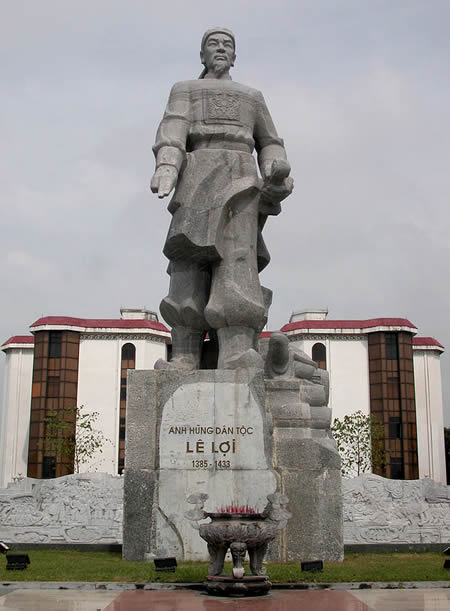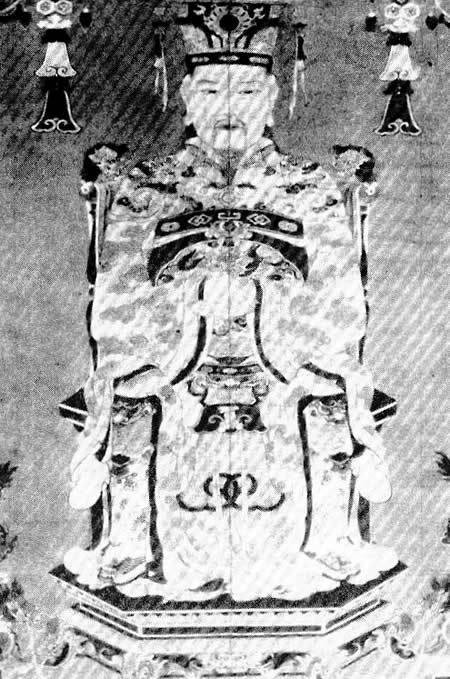World History
At the same time that the Chinese Ming dynasty sent its vast fleets across the Indian Ocean to Africa, it also mounted an invasion of Annam, today part of the Democratic Republic of Vietnam. The sudden Ming incursion caused the native Vietnamese Ho dynasty to collapse.
The Ming attack had been precipitated by the coup of Le Qui Ly onto the throne of the Ho dynasty in 1400. He reorganized the kingdom and set about building an especially strong military system, something that the Ming emperor Jianwen (Chien-wen, r. 1399–1402) did not see in the interests of Chinese security.
The occupation of Annam continued until 1407, when Emperor Yongle (Yung-lo, r. 1403–24) brought back the Chinese troops, perhaps because the expense was taking money from his gigantic project of building a large, ocean-going fleet. The impetus for the withdrawal of the Chinese was the rise of Le Loi, who began a fierce resistance struggle against Chinese occupation, which Yongle did not want to see consume his imperial treasury.
Calling himself Prince of the Pacification, Le Loi established what became the Le dynasty in 1428. At that time, Le Loi took the royal title of Le Thai To. He renamed the country Dai Viet and began the process of rebuilding his country after the Ming occupation.
With the Chinese threat removed, he demobilized much of his army to free money for the reconstruction of the country’s infrastructure, which had virtually been destroyed by the Ming. However he followed the Chinese pattern in establishing the new administration for Vietnam. China was governed by the scholar class, recruited through extremely hard examinations.
Thus the emperor governed imperial China through an effective civil service. To reorganize Annam, Le Loi established the College of National Sons to train a civil administration for his kingdom. Entrance to the college was virtually free of influence of birth, thus opening a career of government service to large numbers who would otherwise have been denied entry.
On the death of Le Loi (Le Thai To) in 1443 the country suffered a period of disorder until his son, Le Thanh Tong, was able to assert his claim to his father’s throne. He ruled from 1460 to 1497. Le Thanh Tong built on the administrative foundations laid by his father. At the same time, he carried out the expansion of his kingdom.
To the south, he invaded the Champa kingdom. However Le Thanh To was careful about antagonizing China and was scrupulous about his payment of tribute to the Ming court. At the same time on his western frontier, he repelled raids from the Lao people, from whom modern Laos derives its name. It was clear in his conquest of Champa that he intended to colonize, not just raid.
Le Thanh established military colonies of Annamese veterans in the region to weld it to his kingdom. Moreover, the opening of Champa served as a “new frontier†for the Annamese people of Dai Viet, giving many peasants the opportunity to farm land there, which they did not have in their original homeland.
Upon Le Thanh’s death in 1497 the Le dynasty entered a period of fatal decline. In 1527 Mac Dang Dong, one of the administrative mandarins, seized the throne after having already been effective ruler for a decade. The Nguyen and Trinh families, loyal to the Le dynasty, rebelled against Mac Dang Dong. The realm of the old Le dynasty was destroyed from within.
- Yongle (yung-lo) - Chinese Emperor
Yongle (Yung-lo) - Chinese EmperorThe man who became the third ruler of China’s Ming dynasty (1368–1644) as Emperor Yongle (Yung-lo) (meaning “lasting joyâ€) was the fourth son of Zhu Yuanzhang (Chu Yuan-chang), the dynastic founder....
- Abahai Khan - Manchu Military
Abahai Khan - Manchu MilitaryAbahai (also named Hung Taiji) was the eighth son of Nurhaci, a Jurchen tribal chieftain who founded the Manchu state in what is today northeastern China. Elected by the Hosoi Beile, or council of clan princes and nobles,...
- Dorgon
Prince DorgonDorgon was regent for his nephew between 1644 and 1650. He seized the opportunity offered by Ming general Wu Sangui (Wu San-kuei) to lead the Manchu forces inside the Great Wall and together to defeat the rebels who had seized Beijing (Peking)...
- The Great Wall Of China
The Great Wall of China Most of the Great Wall of China that stands now was built in the second half of the 16th century during the Ming dynasty to connect the principal garrison points of the Ming defensive system against Mongol attacks. Being northern...
- Qing Tributary System
Qing Tributary System The Chinese tributary system dated to the Han dynasty (202 b.c.e.–220 c.e.). It reflected the Chinese worldview that China was the center of the civilized world, and that all lands desiring relations with China must be tributary...
World History
Le Dynasty of Annam
 |
| Le Loi - Le dynasty founder |
At the same time that the Chinese Ming dynasty sent its vast fleets across the Indian Ocean to Africa, it also mounted an invasion of Annam, today part of the Democratic Republic of Vietnam. The sudden Ming incursion caused the native Vietnamese Ho dynasty to collapse.
The Ming attack had been precipitated by the coup of Le Qui Ly onto the throne of the Ho dynasty in 1400. He reorganized the kingdom and set about building an especially strong military system, something that the Ming emperor Jianwen (Chien-wen, r. 1399–1402) did not see in the interests of Chinese security.
The occupation of Annam continued until 1407, when Emperor Yongle (Yung-lo, r. 1403–24) brought back the Chinese troops, perhaps because the expense was taking money from his gigantic project of building a large, ocean-going fleet. The impetus for the withdrawal of the Chinese was the rise of Le Loi, who began a fierce resistance struggle against Chinese occupation, which Yongle did not want to see consume his imperial treasury.
  |   |
Calling himself Prince of the Pacification, Le Loi established what became the Le dynasty in 1428. At that time, Le Loi took the royal title of Le Thai To. He renamed the country Dai Viet and began the process of rebuilding his country after the Ming occupation.
With the Chinese threat removed, he demobilized much of his army to free money for the reconstruction of the country’s infrastructure, which had virtually been destroyed by the Ming. However he followed the Chinese pattern in establishing the new administration for Vietnam. China was governed by the scholar class, recruited through extremely hard examinations.
Thus the emperor governed imperial China through an effective civil service. To reorganize Annam, Le Loi established the College of National Sons to train a civil administration for his kingdom. Entrance to the college was virtually free of influence of birth, thus opening a career of government service to large numbers who would otherwise have been denied entry.
On the death of Le Loi (Le Thai To) in 1443 the country suffered a period of disorder until his son, Le Thanh Tong, was able to assert his claim to his father’s throne. He ruled from 1460 to 1497. Le Thanh Tong built on the administrative foundations laid by his father. At the same time, he carried out the expansion of his kingdom.
 |
| Le Thanh Tong |
To the south, he invaded the Champa kingdom. However Le Thanh To was careful about antagonizing China and was scrupulous about his payment of tribute to the Ming court. At the same time on his western frontier, he repelled raids from the Lao people, from whom modern Laos derives its name. It was clear in his conquest of Champa that he intended to colonize, not just raid.
Le Thanh established military colonies of Annamese veterans in the region to weld it to his kingdom. Moreover, the opening of Champa served as a “new frontier†for the Annamese people of Dai Viet, giving many peasants the opportunity to farm land there, which they did not have in their original homeland.
Upon Le Thanh’s death in 1497 the Le dynasty entered a period of fatal decline. In 1527 Mac Dang Dong, one of the administrative mandarins, seized the throne after having already been effective ruler for a decade. The Nguyen and Trinh families, loyal to the Le dynasty, rebelled against Mac Dang Dong. The realm of the old Le dynasty was destroyed from within.
- Yongle (yung-lo) - Chinese Emperor
Yongle (Yung-lo) - Chinese EmperorThe man who became the third ruler of China’s Ming dynasty (1368–1644) as Emperor Yongle (Yung-lo) (meaning “lasting joyâ€) was the fourth son of Zhu Yuanzhang (Chu Yuan-chang), the dynastic founder....
- Abahai Khan - Manchu Military
Abahai Khan - Manchu MilitaryAbahai (also named Hung Taiji) was the eighth son of Nurhaci, a Jurchen tribal chieftain who founded the Manchu state in what is today northeastern China. Elected by the Hosoi Beile, or council of clan princes and nobles,...
- Dorgon
Prince DorgonDorgon was regent for his nephew between 1644 and 1650. He seized the opportunity offered by Ming general Wu Sangui (Wu San-kuei) to lead the Manchu forces inside the Great Wall and together to defeat the rebels who had seized Beijing (Peking)...
- The Great Wall Of China
The Great Wall of China Most of the Great Wall of China that stands now was built in the second half of the 16th century during the Ming dynasty to connect the principal garrison points of the Ming defensive system against Mongol attacks. Being northern...
- Qing Tributary System
Qing Tributary System The Chinese tributary system dated to the Han dynasty (202 b.c.e.–220 c.e.). It reflected the Chinese worldview that China was the center of the civilized world, and that all lands desiring relations with China must be tributary...
